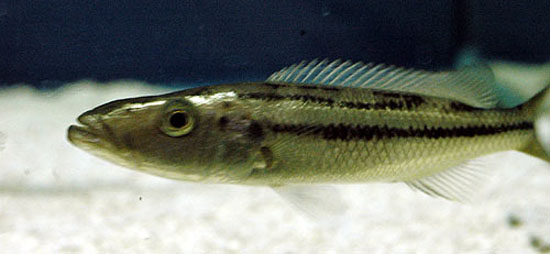| Cichlidae (Cichlids), subfamily: Pseudocrenilabrinae |
| 42 cm SL (male/unsexed) |
|
demersal; freshwater; pH range: 7.4 - 8.5; dH range: 5 - 30; depth range 2 - 65 m |
| Africa: Endemic to Lake Malawi. |
|
Diagnosis: elongated and very streamlined shape; body in cross-section more rounded than congenerics; frequently exhibits a horizontal stripe (Ref. 55949).
Description: large, rather cylindrical species with very slender body; lower jaw very deep with smooth surface; teeth short, straight and widely-spaced, generally not visible when the mouth is closed (Ref. 55949).
Coloration: countershaded, dark grey dorsally usually with a blue metallic iridescence in life; usually with an indistinct dark horizontal stripe on the flanks; pelvic and anal fins either grey-white or orange; sometimes 2-9 orange-yellow eggspots on anal fin (Ref. 55949). |
| Inhabits the open water (Ref. 5595). Widely distributed in shelf and rocky reef zones, usually where the bottom is fairly shallow; rarely found offshore; small juveniles widely distributed in the littoral zone in swampy, sandy and rocky habitats; adults regularly encountered near sandy beaches in the shallows (Ref. 55949). Feeds on fish species like the small Utaka and the lake sardine Usipa (Engraulicypris sardella) (Ref. 5595). |
|
Vulnerable (VU); Date assessed: 23 May 2018 (A2d) Ref. (130435)
|
| harmless |
Source and more info: www.fishbase.org. For personal, classroom, and other internal use only. Not for publication.

